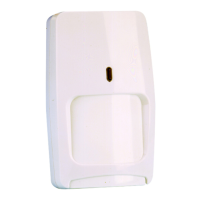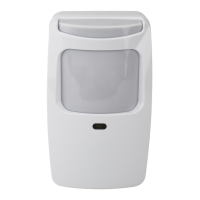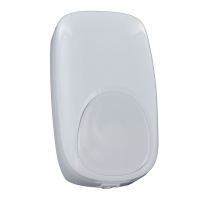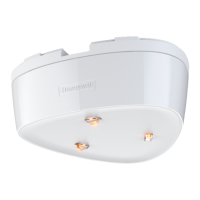Sensors DUAL TEC FAMILY FEATURES
FEATURES
65
Pet Immune to 100 lbs.:
Sensor is immune to pets and other
animals with combined weight of 100 lbs
when installation guidelines for pet
immunity are followed.
Coverage pattern:
Length by width of area protected.
Signal Processing:
Analysis performed on PIR and microwave
signals to determine alarm conditions.
• DualCore: Signals are analyzed in
multiple domains, including amplitude,
time, frequency and duration. Supports
functions including diagnostics and
other advanced false alarm features.
• C
3
: Correlates data from both channels
simultaneously, instead of independently
processing each
• MAP: Timing and sequence of signals
are compared to settings for specific
environments to qualify each channel
individually
• Queue Event Logic: Pulse counting
while looking for specific sequences
of events
• Advanced: Pulse counting with timing
relationships
• Standard: Basic pulse counting
Optical Technology:
Technology used to collect infrared
radiation for PIR processing.
• Uniform Sensitivity: Fresnel lens that
provides the same sensitivity at the edge
of the pattern as exists directly in front
of the sensor
• Split-Zone: Zones are split into two
sub-zones where each sub-zone has
half the sensitivity of a regular zone,
requiring targets to be in both zones
for an alarm
• Standard: Basic Fresnel lens
• Mirror: Basic mirror optics
Microwave Frequency Band:
Frequency at which the microwave signal
is radiated and received. Higher frequencies
generally penetrate non-metallic objects
less than lower frequencies.
• S-Band: 2.54 GHz
• X-Band: 10.525 GHz
• K-Band: 24.125 GHz
Environmental Adaption:
Microwave thresholds are adapted either
in hardware or digitally to remove the
effect of low level interference such as
ceiling fans.
Temperature Compensation:
Sensor automatically adjusts PIR
thresholds and/or other parameters to
adapt to change in ambient temperature
relative to human body temperature.
• Standard: Compensates at ambient
temperatures below body temperature
• Advanced: Compensates at ambient
both below and above body temperature
Digital Fluorescent Light Filter:
Software algorithms provide infinite
rejection of microwave interference due
to fluorescent lights.
Analog Fluorescent Light Filter:
Hardware circuitry provides rejection
of microwave interferences due to
fluorescent lights.
Anti-Masking:
Detects intentional and accidental
blocking of the PIR optics.
Walk Test Mode:
Determines the coverage pattern and
functionality for both the PIR and
microwave channels, usually through
LED indicators.
PIR Sensitivity Adjustment:
Selectable option to change the PIR
process sensitivity, usually through a
DIP switch or jumper link.
Microwave Sensitivity Adjustment:
Selectable option to change the microwave
sensitivity and/or range, usually through a
potentiometer.
Vertical Adjustment:
Capability to adjust the vertical PIR detec-
tor position relative to the optics, usually
through a vertical shift in the PCB. Usually
used to adjust range at different mounting
heights, or accurately set the coverage
pattern for different lenses or mirrors.
Horizontal Adjustment:
Capability to shift the PIR zones left or
right by a few degrees. Usually used to
locate potential false alarm sources, such
as a heating vent between zones, or to
aim the optics in a particular direction,
such as a hallway.
Trouble Output:
Separate output used to indicate
supervision failures and/or anti-mask
detection to the control panel.
Alarm Relay Forms:
Type of output relay used to signal panel
when an intrusion is detected.
• Form A: Two-terminal relay with
Normally Closed output when energized
• Form C: Three-terminal relay with both
Normally Closed and Normally Open
outputs when energized
LED Indicators:
Light Emitting Didoes used to provide
visual feedback about alarm state,
supervision, walk test, and other modes
of operation.
• 1 LED: Single red LED
• 3 LEDs: Red, green, yellow LEDs,
usually with PIR and microwave
channels associated with a specific
color
Microwave Supervision:
Automatic self-test of microwave channel
for proper operation.
PIR Supervision:
Automatic self-test of microwave channel
for proper operation.
Recommended Mounting Height:
Suggested height to mount processor for
optimal performance. Usually important
for pet immune applications.
Operating Temperature:
Temperature range at which the sensor
can be expected to provide adequate
protection. UL certification may have a
narrower range.
Input Voltage:
Voltage range at the terminal strip at
which the sensor will operate. UL may
have certified for a slightly narrower range.
Swivel Bracket Options:
Brackets used to mount sensors in
installations that have special aiming
or mounting heights.

